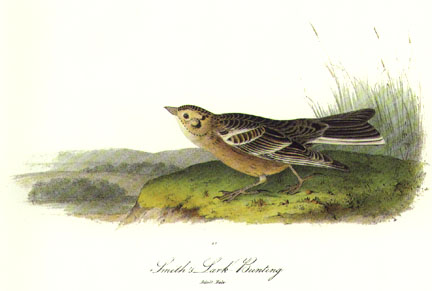

487 SMITH'S LARK BUNTING
| This species was discovered by my companions, EDWARD HARRIS and J.
G. BELL, during an excursion on the prairies of Illinois, in the
vicinity of Edwardsville. Several specimens were procured by those
gentlemen, and the following account of its habits has been handed to me
by Mr. BELL. He says--
"We found these birds very abundant on the low prairie, near a lake in Illinois, about seven or eight miles distant from Edwardsville, whilst engaged in shooting Ducks, Geese, and American Snipes. They were generally in large flocks, and when on the ground they at once began to scatter and divide themselves, rendering it difficult for us to kill more than two at one shot; they run very nimbly, and in a manner resembling that of the Bay-winged Bunting (Emberiza graminea), when they arose, which they seldom did until very nearly approached. They utter a sharp click, repeated several times in quick succession, and move off with an easy undulating motion, for a short distance, and alight very suddenly, like many other birds of this family; seeming to fall as it were perpendicularly for several feet to the ground. They seemed to prefer the spots where the grass was shortest. When a single one arose it would fly a short distance and realight; but if three or four started together, the remainder became alarmed, and the whole flock (sometimes containing several hundreds) would start simultaneously. When in the air they flew in circles to and fro for a few minutes, and again alighted. We could see the white spot on the wing, either when they were on the ground or on the wing. We could see them much better among the grasses whilst on horseback, and seldom saw them on the wing unless disturbed; and when in the air they kept up a constant chirping or call, somewhat resembling that of the Little Red Poll; and very frequently a couple would separate themselves from the great flock, and would pursue one another as if in play or with the desire to fight, and again return to the main body. It was too early in the season and no nests were found; indeed it is probable that this species removes far to the north to breed. I have honoured this species with the name of my good friend GIDEON B. SMITH, Esq., M. D., of Baltimore, Maryland; who has done much for science in several of its departments. SMITH'S LARK-BUNTING, Plectrophanes Smithii, Aud. 6 1/8. Prairies of Illinois, &c. Very abundant. Male in April. All the upper parts are light dull yellowish-brown, streaked with brownish-black. A medial line on the head, another over the eye, with the cheeks and whole lower parts, of the same dull yellowish-brown as the upper surface, streaked on the breast and along the sides with brownish-black. A large patch of white occupies the pinion of the wing, and the smaller coverts are marked with black surrounded by white, forming a second row of white. All the quills are brownish-black, edged with white or whitish, the second and third quills are longest. Tail as the back and wings, excepting two feathers outside that are white, with a streak of brownish-black on the outer vein, and a broader one of the same colour on the inner; and this is conspicuous when the bird is on the wing. Bill and feet brownish-black, the feet darker as well as the claws. Eyes brown. Whole length 6 1/8 inches; tail 2 1/2; wing from flexure 3 3/4; bill along the ridge 3/8, along the gap 1/2; tarsus 3/4; middle toe 5/8, its claw (1 1/2)/8; hind toe 3/8, its claw 3/8. No difference appears at this season in the sexes.
|